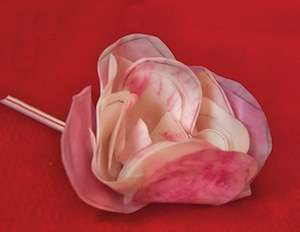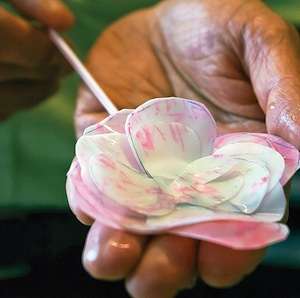'Smart' medical material aims to unfurl at 98.6 degrees

(Phys.org) —Mechanical Engineering Professor Lih-Sheng (Tom) Turng has a simple office demonstration of how shape-memory polymers work. He takes the material, which is formed into a compact flower bud, drops the bud in a cup of warm water, and voila: A daisy slowly blooms.
A significant materials research advance by Turng and colleagues may help this shape-shifting phenomenon translate to human medicine.
Turng and PhD students Hao-Yang Mi and Xin Jing have discovered a new blend of shape-memory polymer that can regain its predetermined shape when exposed to heat levels close to human body temperature. This could have exciting implications for surgical implants such as stents and artificial arteries, which could be implanted in compact form and regain their desired shape naturally in the body.
"This material has some amazing recovery properties," says Turng, a professor of mechanical engineering and director of the BIONATES biopolymer research program at the Wisconsin Institutes for Discovery. "Our ultimate goal is to create shape-memory materials that will regain their permanent shape at human body temperature."
Shape-memory polymers have been around since the 1980s, and have found their way into applications such as sportswear and home building materials. But they currently require too high a temperature trigger to have widespread use in medicine.
The polymer blends devised by Turng's team move from a temporary spiral shape to a memorized permanent straight shape at 70 degrees Celsius. While the goal will be to get the reaction to occur at 37 degrees Celsius, the temperatures are significantly lower than the current state of the art.

"We want to focus on medical applications, with the goal of converting a medical device or surgical implant into a very compact form, making it as non-invasive as possible," Turng says.
The research team uses inexpensive polymer materials commonly used in injection molding environments. The key is combining a mix of polymers with both brittle and elastic properties. The mix used here is amorphous polylactic acid (PLA), derived from corn starch, and thermoplastic polyurethane (TPU), a stretch plastic commonly found in athletic apparel.
The shape-memory discovery actually occurred by accident, says Mi, who was originally testing whether the material was biocompatible and able to support cell growth. He found that while the material is easily deformed, with a little heat it almost immediately retained its shape. "Right now, we're looking for the best combination of materials that will bring down the transition temperature," he says.
Jing noted that for medical applications such as tissue scaffolding, bone grafts or ligaments, the materials will need "quite a bit of rigidity." The team's current materials are too brittle, so a second focus of continued research will be improving its overall strength for medical applications.
The BIONATES group—which stands for bio-nanocomposite tissue engineering scaffolds—operates out of two core labs at WID. One is a polymer development and fabrication facility that manufactures a variety of materials that may be used in medical scaffolding. The second is a biomedical tissue engineering lab where the team performs cell culture experiments and examines biocompatibility—how well materials support cell growth and facilitate repair of damaged tissue.
The group is following a variety of promising paths, including the use of stem cells in tissue scaffolding and on drug delivery applications embedded within the shape-memory materials.
Provided by University of Wisconsin-Madison


















